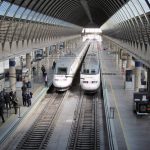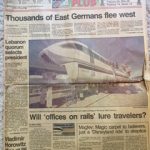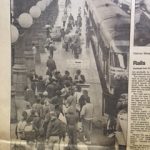The 701 to Sacramento
 Fresno mayor Lee Brand is off to ride the fast train in Spain. A couple of City Council members and others are with him on the fact-finding trip organized by the Fresno County Economic Development Corp., which will tour facilities in Barcelona, Madrid, and Ciudad Real. They are not the first.
Fresno mayor Lee Brand is off to ride the fast train in Spain. A couple of City Council members and others are with him on the fact-finding trip organized by the Fresno County Economic Development Corp., which will tour facilities in Barcelona, Madrid, and Ciudad Real. They are not the first.
 A story in the Fresno Bee on November 6, 1989 by reporter Mary Pitman raved about a junket to West Germany by (then) State Assemblyman Jim Costa (D-Fresno), and a group of high-speed rail dreamers who were swept off their feet by German technology called maglev that moved passenger trains at up to 210 miles an hour using magnetic forces. Californians have long dreamed of a fast, efficient, economical, comfortable train to haul people from north to south and east to west over a vast geological area – like the best ones in Europe, Japan, China and elsewhere. Back in the day rail travel was a treat: (You know,) polite helpful porters, conductors, and ticket agents; sparkling clean and safe stations and coaches; comfortable seating with plenty of legroom and space to roam; dining cars, where quality meals were served on linen-draped tables set with china, crystal, and silverware; punctual departures and arrivals – in short, a civilized way to get from point-A to point-B as a viable alternative to supposedly superior air travel.
A story in the Fresno Bee on November 6, 1989 by reporter Mary Pitman raved about a junket to West Germany by (then) State Assemblyman Jim Costa (D-Fresno), and a group of high-speed rail dreamers who were swept off their feet by German technology called maglev that moved passenger trains at up to 210 miles an hour using magnetic forces. Californians have long dreamed of a fast, efficient, economical, comfortable train to haul people from north to south and east to west over a vast geological area – like the best ones in Europe, Japan, China and elsewhere. Back in the day rail travel was a treat: (You know,) polite helpful porters, conductors, and ticket agents; sparkling clean and safe stations and coaches; comfortable seating with plenty of legroom and space to roam; dining cars, where quality meals were served on linen-draped tables set with china, crystal, and silverware; punctual departures and arrivals – in short, a civilized way to get from point-A to point-B as a viable alternative to supposedly superior air travel.
The plan back in the eighties was to upgrade existing rail routes owned by the major freight carriers to make them safe for train speeds of 75, 100, and eventually 186 miles per hour (or faster) at a cost of around $3.5-billion. There was talk of gliding on the maglev from Fresno up to Sacramento in 46 minutes, Fresno to Los Angeles in 68 minutes, Fresno to San Francisco in 62 minutes.
That was then, this is now. The price tag approaches $100-billion for an entirely re-envisioned high-speed rail system built from the ground up. Whether it is ever finished is anybody’s guess, but at least construction on the middle 118 miles – Merced to Bakersfield is underway. The new high-speed rail route from Fresno to Sacramento will carve through virgin territory of olive groves, vast vineyards, dairies, and mom & pop businesses and family farms creating untold chaos and resentment because the existing 150-year old right of way is simply not modern enough to suit this season’s cadre of administrators – for example, they’re willing to spend several hundred million dollars to re-align a smidgeon of Highway-99 near downtown Fresno to prove it. Immense new sources of funding (gasoline tax) are being invented to fuel the hungry locomotives. (Executive Membership, by the way, called “TheAuthority” has changed almost entirely in the past year or two: In other words, same old scheme, brand new dreamers.) I’m one of those people who think an incredibly fast passenger train linking the Bay Area to the Southland is a terrific idea. Such a train should have been built a long time ago. But, guess what? It wasn’t. So for now and for the foreseeable future, we’re still riding the 701 to Sac-Town at an average speed of about 40 miles an hour.
It’s Sunday morning, Labor Day Weekend. There are precisely six people waiting inside the Fresno Amtrak Station for the 7:53 San Joaquin northbound train, a few more people are scattered on the covered bench at the boarding platform along the tracks. The computer voice of the Amtrak Lady interrupts this quietude with a public address announcement that the train will be arriving late, thirty-minutes late to be exact, no reason given. At the same moment, a text message is sent to ticket holders’ cell phones (most people purchase online) that the “701” is delayed, now expected to arrive in Fresno at 8:20 am, not 7:50 am – the electronic message board flashes the same advisory. But the Amtrak station ticket-booth lady – a real person, perky friendly helpful – told me moments ago that the train is really on-time, just now leaving Hanford, expected to arrive in Fresno a few minutes early. Oh, oh, all those passengers not yet at the station might be thinking, “Great, plenty of time to get there, no worries.”
At 7:51am about two dozen world travelers climb aboard the double decker coaches and drift toward easy seats. Three minutes later we roll northward. (I’m guessing ten minutes later a small gaggle of misled passengers will be gathered behind the yellow safety line painted on the departure sidewalk with their heads on a swivel looking for a train that just left the station – it wasn’t delayed, after all. A few swear the Amtrak Lady’s voice also said something about Fresno State beating Alabama.)
Seats aboard the coaches are comfortable, spacious, and clean. Some bench seats are arranged around small tables to provide a work space for kids with Legos. There are plug-in sockets to recharge laptops and iPhones and whatnot; other seats are like you would find on a well-equipped tour bus or pick-up lounge, the kind of seats Americans can only dream of ever again finding on an airliner. There is real food, too; served by a real person who appeared to enjoy preparing hot meals (microwaved), cold drinks, sort of frozen ice cream, and an array of crunchy brain food, chips and such.
First stop on the journey to Sacramento is Madera. For fifteen minutes we’ve rolled through the back acres of olive orchards, grape juice factories for the big wineries, and the last few thousand fig trees remaining in America. We’ve also noticed why The (HSR) Authority insists upon blazing a completely new route for the bullet train; it’s because the current right-of-way is so clogged with trash and extra-legal landfill items that no cleanup project would ever suffice. This is institutional trash, layers and layers of it; the daily output of what were once called hobos and tramps, and it is not attractive.
The train stops for about four minutes at Madera’s sleepy little station. People get on, people get off – the passenger coaches are about 20-percent full. We roll again.
The engineer floors it for a minute or two, maybe 50, 60, 70 miles per hour –High Speed Rail 2017! A few minutes later, Merced’s underbelly comes into view. Can the trash along the route be worse than Madera’s? Yes. And, the world’s most colorful graffiti flashes by in a seemingly endless whirl of multicolor swirly-girly fonts shouting the ascension of particular gangs, gang affiliates, gang wannabes, gang has-beens, neighborhood thugs, kids with a can of spray paint, aspiring artists, fools-naves-and-jerks. Everything is tagged or re-tagged along the way. Passengers can peer into the backyards of Central Californians from a distance of maybe 25 feet along stretches of the approach to Merced’s little station. Plastic above-ground pools and trampolines were popular in the 60’s – they’re still around. Nasty old mattresses abound as well, on both sides of tumble down fences. It’s pretty much the same drill as we pass through Turlock, Modesto,Stockton, Lodi, and finally, Sacramento.

The 701 creeps through South Sacramento as it approaches the train station at 401 “I” Street, fronting the Southern Pacific Rail Yards to the north and the State Capitol a few blocks to the south. We file off the train, roughly three hours after leaving Fresno, into a maze of train tracks and tunnels, the circa 1926 terminal building a brisk walk away.

Less than a week later, Lee Brand and his small band of field trippers will be touring the high-speed trains and stations of Spain’s Alta Velocidad Español, said to be one of Europe’s best. Before departing, Brand told Tim Sheehan of the Fresno Bee, “My goal is to understand high-speed rail operations, including station design and how stations affect the areas around them.”
What he meant was, “How we gonna snag that multi-million dollar High Speed Rail Maintenance Facility for Fresno and the 1,500 jobs that come along with it?”
High Speed Rail is coming to Central California. Big time construction is evident all around Fresno. Last week Riverside Nursery closed down because HSR wants to run right through it. Looks like we can’t stop it, we can’t understand it, and we damn sure can’t pay for it.
All aboard!
